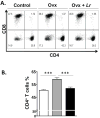Probiotic L. reuteri treatment prevents bone loss in a menopausal ovariectomized mouse model
- PMID: 24677054
- PMCID: PMC4129456
- DOI: 10.1002/jcp.24636
Probiotic L. reuteri treatment prevents bone loss in a menopausal ovariectomized mouse model
Abstract
Estrogen deficiency is a major risk factor for osteoporosis that is associated with bone inflammation and resorption. Half of women over the age of 50 will experience an osteoporosis related fracture in their lifetime, thus novel therapies are needed to combat post-menopausal bone loss. Recent studies suggest an important role for gut-bone signaling pathways and the microbiota in regulating bone health. Given that the bacterium Lactobacillus reuteri ATCC PTA 6475 (L. reuteri) secretes beneficial immunomodulatory factors, we examined if this candidate probiotic could reduce bone loss associated with estrogen deficiency in an ovariectomized (Ovx) mouse menopausal model. Strikingly, L. reuteri treatment significantly protected Ovx mice from bone loss. Osteoclast bone resorption markers and activators (Trap5 and RANKL) as well as osteoclastogenesis are significantly decreased in L. reuteri-treated mice. Consistent with this, L. reuteri suppressed Ovx-induced increases in bone marrow CD4+ T-lymphocytes (which promote osteoclastogenesis) and directly suppressed osteoclastogenesis in vitro. We also identified that L. reuteri treatment modifies microbial communities in the Ovx mouse gut. Together, our studies demonstrate that L. reuteri treatment suppresses bone resorption and loss associated with estrogen deficiency. Thus, L. reuteri treatment may be a straightforward and cost-effective approach to reduce post-menopausal bone loss.
© 2014 Wiley Periodicals, Inc.
Conflict of interest statement
All authors state that they have no conflict of interest.
Figures






Similar articles
-
Probiotics protect mice from ovariectomy-induced cortical bone loss.PLoS One. 2014 Mar 17;9(3):e92368. doi: 10.1371/journal.pone.0092368. eCollection 2014. PLoS One. 2014. PMID: 24637895 Free PMC article.
-
Heat-killed Limosilactobacillus reuteri ATCC PTA 6475 prevents bone loss in ovariectomized mice: A preliminary study.PLoS One. 2024 May 31;19(5):e0304358. doi: 10.1371/journal.pone.0304358. eCollection 2024. PLoS One. 2024. PMID: 38820403 Free PMC article.
-
Caffeic acid 3,4-dihydroxy-phenethyl ester suppresses receptor activator of NF-κB ligand–induced osteoclastogenesis and prevents ovariectomy-induced bone loss through inhibition of mitogen-activated protein kinase/activator protein 1 and Ca2+–nuclear factor of activated T-cells cytoplasmic 1 signaling pathways.J Bone Miner Res. 2012 Jun;27(6):1298-1308. doi: 10.1002/jbmr.1576. J Bone Miner Res. 2012. PMID: 22337253
-
Post-menopausal Osteoporosis and Probiotics.Curr Drug Targets. 2021;22(7):816-822. doi: 10.2174/1389450121666201027124947. Curr Drug Targets. 2021. PMID: 33109043 Review.
-
Research progress on Limosilactibacilus reuteri in diseases.Microbiol Res. 2023 Nov;276:127482. doi: 10.1016/j.micres.2023.127482. Epub 2023 Aug 23. Microbiol Res. 2023. PMID: 37660453 Review.
Cited by
-
Links Between the Microbiome and Bone.J Bone Miner Res. 2016 Sep;31(9):1638-46. doi: 10.1002/jbmr.2887. Epub 2016 Jul 26. J Bone Miner Res. 2016. PMID: 27317164 Free PMC article. Review.
-
Precision Nutrition and the Microbiome Part II: Potential Opportunities and Pathways to Commercialisation.Nutrients. 2019 Jun 27;11(7):1468. doi: 10.3390/nu11071468. Nutrients. 2019. PMID: 31252674 Free PMC article. Review.
-
Post-antibiotic gut dysbiosis-induced trabecular bone loss is dependent on lymphocytes.Bone. 2020 May;134:115269. doi: 10.1016/j.bone.2020.115269. Epub 2020 Feb 21. Bone. 2020. PMID: 32061677 Free PMC article.
-
Bone Homeostasis and Gut Microbial-Dependent Signaling Pathways.J Microbiol Biotechnol. 2021 Jun 28;31(6):765-774. doi: 10.4014/jmb.2104.04016. J Microbiol Biotechnol. 2021. PMID: 34176870 Free PMC article. Review.
-
Prebiotic and Probiotic Regulation of Bone Health: Role of the Intestine and its Microbiome.Curr Osteoporos Rep. 2015 Dec;13(6):363-71. doi: 10.1007/s11914-015-0292-x. Curr Osteoporos Rep. 2015. PMID: 26419466 Free PMC article. Review.
References
-
- ESHRE Capri Workshop Group. Bone fractures after menopause. Hum Reprod Update. 2010;16(6):761–773. - PubMed
-
- Abrams SA, Griffin IJ, Hawthorne KM, Liang L, Gunn SK, Darlington G, Ellis KJ. A combination of prebiotic short- and long-chain inulin-type fructans enhances calcium absorption and bone mineralization in young adolescents. The American journal of clinical nutrition. 2005;82(2):471–476. - PubMed
-
- Backhed F, Fraser CM, Ringel Y, Sanders ME, Sartor RB, Sherman PM, Versalovic J, Young V, Finlay BB. Defining a healthy human gut microbiome: current concepts, future directions, and clinical applications. Cell host & microbe. 2012;12(5):611–622. - PubMed
-
- Bouxsein ML, Myers KS, Shultz KL, Donahue LR, Rosen CJ, Beamer WG. Ovariectomy-induced bone loss varies among inbred strains of mice. J Bone Miner Res. 2005;20(7):1085–1092. - PubMed
Publication types
MeSH terms
Substances
Grants and funding
LinkOut - more resources
Full Text Sources
Other Literature Sources
Medical
Research Materials

